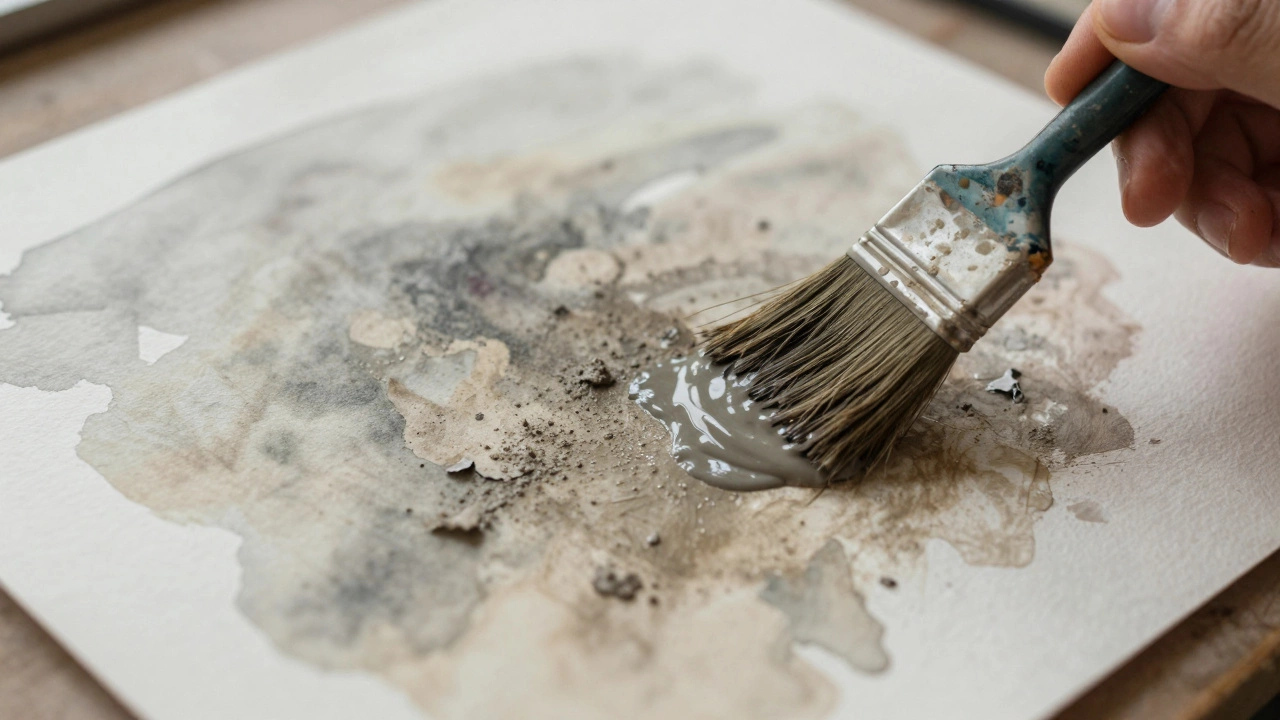Ever found yourself out of linseed oil and eyeing that jar of coconut oil in your kitchen? You’re not the only one. It sounds tempting to use what you have, especially with prices on art supplies creeping up every year. But when it comes to oil painting, not every oil is created equal.
Linseed oil is the MVP in oil painting medium for a reason. It dries reasonably fast, makes your colors pop, and helps your paintings last decades—sometimes even centuries. Coconut oil might seem like a decent swap at first glance. It smells nice, it's easy to find, and let’s be real, who hasn’t heard that one friend swear it can do anything?
Before you dip your brush, though, it pays to know what actually happens when you use coconut oil instead of linseed. Spoiler: you might be in for a surprise. Let’s break down what really goes on with these oils so you don’t end up scrubbing a greasy mess off your canvas after weeks of waiting for paint to dry.
- Why Artists Use Linseed Oil
- What Happens With Coconut Oil
- Common Painting Myths and Experiments
- Alternatives and Smarter Options
Why Artists Use Linseed Oil
Walk into any art store and you’ll see linseed oil sitting proudly among oil painting supplies. There’s a reason for that. Linseed oil is basically the gold standard for mixing and thinning oil paints. It does more than just make paint flow smoother—it actually changes the way finished paintings look and last.
Linseed oil is pressed from flax seeds, so it’s plant-based and non-toxic (though you still shouldn’t eat or touch it all day long). The real magic comes from the way it dries. Unlike cooking oils, linseed oil goes through a process called “oxidative polymerization.” Sounds fancy, but all it means is it absorbs oxygen and forms a hard film, which locks pigment in place. This drying process usually takes a few days, making it practical for layers and blending but not so slow you give up.
If you’re curious about how linseed oil stacks up to other oils used in painting, here’s a simple snapshot:
| Oil Type | Drying Speed | Effect on Color | Longevity |
|---|---|---|---|
| Linseed Oil | 2-5 days (touch dry) | Brightens, increases transparency | Decades to centuries |
| Walnut Oil | 4-7 days | Less yellowing, subtle gloss | Decades |
| Safflower Oil | 7+ days | Best for light colors; less yellowing | Less durable |
| Sunflower Oil | 7+ days | Similar to safflower | Less durable |
But it’s not just about drying time. Linseed oil can make your colors more vibrant, especially if you’re using it as a medium while painting. It helps paint glide across the canvas so you get smoother blends and crisper edges when you want them. Some artists also use it for glazing—those thin see-through layers that give oil paintings depth and glow. No wonder it’s trusted by everyone from students to pros at the oil painting game.
- Quick touch-dry within several days keeps your momentum going.
- Keeps paint layers flexible instead of cracking with age.
- Minimizes yellowing compared to cheaper alternatives.
- Easily found and affordable—even on a student budget.
Skip linseed oil and your painting might stay tacky for weeks or never dry properly at all. So if you’re aiming for that classic, professional finish, this oil is a must-have on your supply list.
What Happens With Coconut Oil
Coconut oil and linseed oil might both sound like ordinary household oils, but when it comes to oil painting, they act nothing alike. Here’s where things get tricky: coconut oil just doesn’t dry and harden the way linseed oil does. If you smear some coconut oil on a plate and let it sit for weeks, it’s still greasy. That’s a big problem for painting because you actually want the oil to dry, not stay sticky forever.
The science is simple: linseed oil is a drying oil, meaning it reacts with oxygen over time to form a solid, flexible film. Coconut oil is what’s called a non-drying oil, which basically means it doesn’t set or harden. If you use coconut oil in your paint, your layers might not dry at all—even after months.
Here’s a quick comparison so you can see what you’re dealing with:
| Property | Linseed Oil | Coconut Oil |
|---|---|---|
| Dries? | Yes (5-7 days touch dry) | No (stays greasy) |
| Film Formation | Creates a hard, protective layer | Stays soft, may attract dust/mold |
| Yellowing Over Time | Moderate | Low, but not suitable for painting |
| Common Art Use | Yes | No |
Some artists have tried using coconut oil out of curiosity. Almost every single time, the paint never sets fully. Imagine accidentally brushing against your canvas two weeks later and ending up with oil on your hands and a smudged masterpiece. That’s not fun, and it’s definitely not durable.
There’s a second issue too. Coconut oil can go rancid, especially if it sits exposed to air and light—think smelly, sticky, and potentially moldy paints. Once that happens, your painting could basically ruin itself from inside out. Not worth the risk, right?
If you’re really in a pinch, you’re better off skipping the painting session or trying a different technique that doesn’t rely on oils. Using coconut oil might seem like a smart hack, but it could cost you weeks of work and wasted supplies.

Common Painting Myths and Experiments
Let’s talk about the idea that you can swap any kitchen oil into your paint and expect the same results. One of the most common myths is that coconut oil works just like linseed oil for oil painting, but that’s nowhere close to reality. Plenty of artists online have tried, thinking it could save a trip to the art store.
Here’s what really happens when you experiment with coconut oil in oil paints. At first, it can look okay—your brush slides smoothly, colors blend, and everything seems fine. The trouble shows up fast, though. Coconut oil doesn’t dry the way linseed oil does. Even after weeks or months, the paint feels sticky. It collects dust, never hardens, and can even go rancid, leaving your painting smelling weird and looking greasy.
There have been actual side-by-side experiments where artists made swatches with coconut oil, olive oil, and linseed oil. Only the linseed oil dried solid and clear, while the coconut and olive oil parts stayed tacky. Months later, those spots looked just as shiny and soft, which means your painting never fully sets and can easily get ruined by a stray elbow or a curious pet.
Another popular myth says that coconut oil is somehow "healthier" for paintings or safer because people cook with it. But that doesn’t matter when it comes to how oils react on canvas. Linseed oil goes through a chemical process called polymerization, which is why it hardens to a solid film. Coconut oil can’t do that—it wasn’t made for painting.
If you’re still curious, go ahead and do your own mini experiment with scraps of canvas. Just don’t use anything important. Seeing it yourself makes it clear why artists have stuck with linseed oil for hundreds of years—it actually works for the job, while coconut oil is better left on your toast than your painting.
Alternatives and Smarter Options
So coconut oil isn’t the magic fix for oil painting, but you still have some solid choices if you can’t or don’t want to use linseed oil. Let’s talk about what actually works and why these swaps are worth a shot instead of rolling the dice with your pantry oils.
The top pick for replacing linseed oil is walnut oil. It dries a bit slower, but it won’t yellow as much over time and it keeps pigments looking vibrant. Gamblin and M. Graham both make artist-grade walnut oils that you can find in most art stores. People even say the smell is more pleasant than linseed’s usual earthiness.
Poppyseed oil is another option, especially for folks who like working with whites and pastels. It’s less likely to yellow, but it can take forever to dry—sometimes weeks. If you’re patient, it’s a good pick for glazing. Just don’t use it for the bottom layers or you’ll risk cracking.
Safflower oil shows up in a lot of student-grade paints. It’s pretty similar to poppyseed oil—slower drying, decent color retention, and it causes less yellowing than linseed. However, just like poppy, you’ll need to be careful using it in your underpainting or thick layers because slow drying can cause issues down the line.
If unique effects are your thing, a few brands now offer specialty painting mediums like alkyd mediums (such as Galkyd or Liquin). Alkyd speeds up drying and keeps your paint flexible, so it’s great for people who like to layer fast. These products are made for art, not for cooking or DIY skincare, so you avoid the big unknowns that come with coconut oil.
- Coconut oil isn’t made for painting. Stick to linseed, walnut, safflower, or poppyseed for better results.
- Always check labels to make sure you’re using a product intended for artists, not for culinary use.
- If allergies or sensitivities are an issue, walnut oil is gentler on the nose and skin than linseed for some people.
- Keep in mind that drying times and yellowing vary—choose your oil based on your project’s needs.
Thinking outside the box isn’t bad, but sometimes old-school solutions really do work best. The bottom line: leave the coconut oil for your stir fry and hair masks, and pick an oil designed for art when you’re ready to paint.





